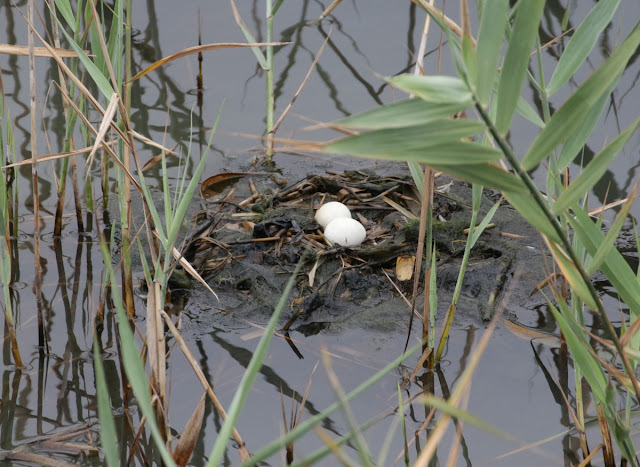It's rare to see a wild bird actually lay an egg. Usually laying takes place out the sight of prying eyes, whether in a deep-cupped or domed nest, a tree cavity, high overhead in a tree or on a cliff ledge. Even ground nesters tend to select a site with surrounding cover. Grebes are some of the few birds which can sometimes have more exposed nest sites but it still takes luck to be in the right place at the right time; luck or more patience than I have.
Last week I was in the right place at the right time as my attention was caught by a pair of trilling Little Grebes swimming quickly in my direction towards some sparse reeds. To my surprise one of them leapt out of the water onto a nondescript soggy patch of waterlogged vegetation and promptly laid an egg. This female then slipped off, dived and I didn't see her again while the male floated around occasionally slapping more gloopy material to the morass. Just before I left the male climbed onto the platform and began fanning the egg with rapid wingbeats, presumably because of the midday heat though I'd have thought that it was sitting in a puddle would have been doing the job just fine.
 |
| The weight of the female was enough to tilt the platform causing water to spill across. The male on the right is bringing more material to add to the 'structure'. |
 |
| The male remained in attendance during the 10-15 minutes I was present. |
 |
| About 30 seconds of rapid wingbeats was presumably to cool the egg. |
 |
| And even a little backward fanning. |
Little Grebes may build a number of trial platforms before selecting one for the nest but it seems this pair may have been a tad behind on the construction front.
When I returned three days later the premature excuse for a nest, and its egg, was abandoned and in even worse condition than it had been. However after a few minutes I spotted another platform, actually worthy of the name nest, containing two eggs.
 |
| The three-day-old egg slowly sinking into the fly-covered mess. |
 |
| And this is how it should be done. |
Egrets were definitely on the move, both Eastern Cattle and Intermediate have reappeared across the fields and were taking advantage of widespread grass cutting around the berms. Another migrant coming through now is Pacific Golden Plover but they can be far more difficult to find as suitable fields are far fewer. However there were pretty good numbers last week, I saw even more of them than the ever present Grey-headed Lapwing. The most unexpected sighting in the rice fields was a Ruddy-breasted Crake. On the rare occasions I see them, or more often hear them, they're in more marshy areas with reeds and pools. This individual crossed the narrow farm road in front of me but despite it being fairly close I could only manage a poor quality shot through the windscreen.
 |
| A luck shot through the windscreen of a Ruddy-breasted Crake just before it disappeared into the rice crop. |
 |
| In contrast to the Crake, Eastern cattle and Intermediate Egrets are conspicuous throughout the area. |
 |
| Pacific Goldies were in reasonably good numbers last week, I found small parties on several fields. |
 |
| Grey-headed Lapwings are a fixture here but I never tire of seeing them. |
















No comments:
Post a Comment